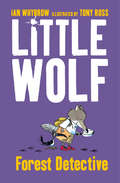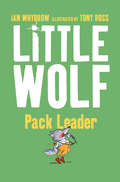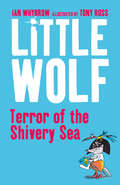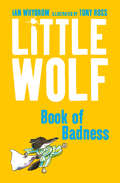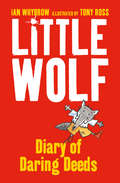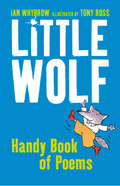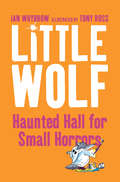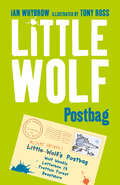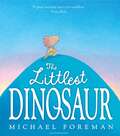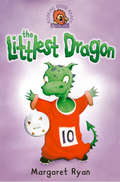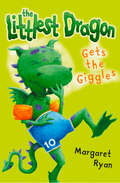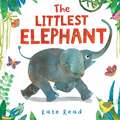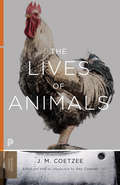- Table View
- List View
The Little War Cat
by Hiba Noor KhanInspired by a true story, The Little War Cat is a moving tale of hope amidst conflict, written by debut author Hiba Noor Khan and beautifully illustrated by the astonishing Laura Chamberlain. The Little War Cat follows the story of a little grey cat who is caught up in the BANGS and CRASHES of the humans in boots, who have changed the city of Aleppo she knew so well into one that's harder to recognize. She is roaming the streets looking for food and shelter when an unlikely friend appears. He shows her that kindness is still there when you look for it, and soon the little grey cat knows exactly what to do to made a difference herself.
Little Wolf, Forest Detective (Middle Grade Fiction Ser.middle Grade Fiction)
by Ian WhybrowA fifth title [fourth novel] about Little Wolf as he and his friends set up the Yelloweyes Forest Detective Agency.
Little Wolf, Pack Leader (Little Wolf Adventures Ser.)
by Ian WhybrowA fifth novel about this prize-winning wolfcub, illustrated by TONY ROSS.
Little Wolf, Terror of the Shivery Sea (Little Wolf Adventures Ser.)
by Ian WhybrowA sixth Little Wolf novel featuring this number one cub and pack of friends as they have the pirate adventure of a lifetime!
Little Wolf’s Book of Badness (Oberon Plays For Young People Ser.)
by Ian WhybrowA new edition of the first novel about much-loved character Little Wolf from the author of the MEERKAT MADNESS books and HARRY AND THE BUCKETFUL OF DINOSAURS.
Little Wolf’s Diary of Daring Deeds (Middle Grade Fiction Ser.middle Grade Fiction)
by Ian WhybrowA new edition of the second novel about much-loved character Little Wolf, as he sets up his Adventure Academy with his cousin Yeller and little brother Smellybreff. From the author of the MEERKAT MADNESS books and HARRY AND THE BUCKETFUL OF DINOSAURS.
Little Wolf’s Handy Book of Poems: Handy Book Of Peoms
by Ian WhybrowLittle Wolf’s ditties – his observations on life told in verse form.
Little Wolf’s Haunted Hall for Small Horrors (Middle Grade Fiction Ser.middle Grade Fiction)
by Ian WhybrowA third Little Wolf novel told through letters. Little Wolf and friends are opening their new school where the lessons are Hunting for Gold by day and Haunting and Spooking by night.
Little Wolf’s Postbag
by Ian WhybrowA ‘Little Wolf’ special for committed fans and new recruits as Little Wolf becomes ‘agony nephew’ for WolfWeekly.
The Littlest Dinosaur
by Michael ForemanA tiny dinosaur is born to a family of rather huge dinosaurs and everyone is mystified about why it is so different. As the littlest dinosaur grows, it feels left out and at odds with the world of its huge family, until one day its very size is the thing that rescues them all. A charming tale featuring every toddler's favourite - dinosaurs - with a sweetly told message about being happy being yourself.Brilliantly read by Claire Skinner. Please note that audio is not supported by all devices, please consult your user manual for confirmation.
The Littlest Dinosaur and the Naughty Rock
by Michael Foreman Camilla ReidThe littlest dinosaur is in a bad mood. He sulks, shouts and throws his food on the ground. When he's sent to the naughty rock, he gets a bit of a surprise and some very helpful advice on how to handle his sulkiness.A perfect book that will ring a bell with every family who has wrestled with a toddler's temper.Brilliantly read by Claire Skinner. Please note that audio is not supported by all devices, please consult your user manual for confirmation.
The Littlest Dinosaur's Big Adventure
by Michael ForemanThe littlest dinosaur gets lost one day when he goes out on his own. While at first it is all a lot of fun, soon he starts to get concerned, particularly when he starts to hear some crying from behind a tree! When he finds out who is crying, the littlest dinosaur has to be much braver than he thought he could be.Brilliantly read by Claire Skinner. Please note that audio is not supported by all devices, please consult your user manual for confirmation.
The Littlest Dragon (Collins Yellow Storybooks Ser.)
by Margaret RyanThe youngest of ten dragon brothers, the Littlest Dragon always has the best and brightest ideas for getting his own way. First book about this successful character. A Collins Roaring Good Read for new readers.
The Littlest Dragon Gets the Giggles (Collins Storybook Ser.)
by Margaret RyanThe second book about the Littlest Dragon who has the biggest and best ideas. Familiar family stories for beginner readers.
The Littlest Elephant
by Kate ReadThe littlest elephant is always in a rush, and it takes a tiny mouse to show her how to slow down and notice the other jungle creatures in this funny, colourful story from Kate Read, creator of the multi-award-winning One Fox. The bright and richly illustrated pages full of jungle creatures from a chameleon to a tiger will entrance any child as they follow the littlest elephant on her way to the pool for a swim. At first she is too excited to notice the chaos she is causing, but then she realizes that by slowing down and helping others, everyone can join in the fun. A beautiful and humorous book about learning empathy for others and helping those who may need it.
Liver Growth and Repair
by A. Strain A. M. DiehlNelson Fausto The Greek myth of Prometheus with its picture of a vulture feasting on its chained victimhas traditionallyprovided a visualimageofliverregeneration. Itis apowerful and frightening representationbut ifone were to substitute the vulture by a surgeon and Prometheus by a patient laying on a properly prepared operating table, the outcomeoftheprocedurewould not differ significantlyfrom that describedbyGreek poets. Yet few of us who work in the field have stopped long enough to ask where this myth originated. Did the poet observe a case of liver regeneration in a human being? Was it brilliant intuition or perhaps, literally, just a 'gut feeling' of a poet looking for good rhymes that led to the prediction that livers grow when part of the tissueisremoved? Thisbookdoesnotattemptto solve these historical issues. Itdoes, instead, cover in detail some of the major modem themes of research on liver regen eration, injury and repair. As indicated in Dr. N. Bucher's chapter, the modem phase ofexperimental studies on liver regeneration started in 1931 with the publication by Higgins and Anderson of a method to perform a two-thirds resection of the liver of a rat. The technique described has 3 remarkable features: 1) it is highly reproducible, resulting in the removal of 68% of the liver, 2) it has minimal if any mortality, and 3) it consists only of blood vessel ligation and does not involve cutting through or wounding hepatic tissue.
The Lives and Deaths of Shelter Animals: The Lives and Deaths of Shelter Animals
by Katja M. GuentherMonster is an adult pit bull, muscular and grey, who is impounded in a large animal shelter in Los Angeles. Like many other dogs at the shelter, Monster is associated with marginalized humans and assumed to embody certain behaviors because of his breed. And like approximately one million shelter animals each year, Monster will be killed. The Lives and Deaths of Shelter Animals takes us inside one of the country's highest-intake animal shelters. Katja M. Guenther witnesses the dramatic variance in the narratives assigned different animals, including Monster, which dictate their chances for survival. She argues that these inequalities are powerfully linked to human ideas about race, class, gender, ability, and species. Guenther deftly explores internal hierarchies, breed discrimination, and importantly, instances of resistance and agency.
The Lives of Animals: The Lives of Animals [Princeton Classics]
by J. M. Coetzee Amy GutmannThe idea of human cruelty to animals so consumes novelist Elizabeth Costello in her later years that she can no longer look another person in the eye: humans, especially meat-eating ones, seem to her to be conspirators in a crime of stupefying magnitude taking place on farms and in slaughterhouses, factories, and laboratories across the world. Costello's son, a physics professor, admires her literary achievements, but dreads his mother’s lecturing on animal rights at the college where he teaches. His colleagues resist her argument that human reason is overrated and that the inability to reason does not diminish the value of life; his wife denounces his mother’s vegetarianism as a form of moral superiority. At the dinner that follows her first lecture, the guests confront Costello with a range of sympathetic and skeptical reactions to issues of animal rights, touching on broad philosophical, anthropological, and religious perspectives. Painfully for her son, Elizabeth Costello seems offensive and flaky, but—dare he admit it?—strangely on target. In this landmark book, Nobel Prize–winning writer J. M. Coetzee uses fiction to present a powerfully moving discussion of animal rights in all their complexity. He draws us into Elizabeth Costello’s own sense of mortality, her compassion for animals, and her alienation from humans, even from her own family. In his fable, presented as a Tanner Lecture sponsored by the University Center for Human Values at Princeton University, Coetzee immerses us in a drama reflecting the real-life situation at hand: a writer delivering a lecture on an emotionally charged issue at a prestigious university. Literature, philosophy, performance, and deep human conviction—Coetzee brings all these elements into play. As in the story of Elizabeth Costello, the Tanner Lecture is followed by responses treating the reader to a variety of perspectives, delivered by leading thinkers in different fields. Coetzee’s text is accompanied by an introduction by political philosopher Amy Gutmann and responsive essays by religion scholar Wendy Doniger, primatologist Barbara Smuts, literary theorist Marjorie Garber, and moral philosopher Peter Singer, author of Animal Liberation. Together the lecture-fable and the essays explore the palpable social consequences of uncompromising moral conflict and confrontation.
The Lives of Animals: The Lives of Animals [Princeton Classics]
by J. M. Coetzee Amy GutmannThe idea of human cruelty to animals so consumes novelist Elizabeth Costello in her later years that she can no longer look another person in the eye: humans, especially meat-eating ones, seem to her to be conspirators in a crime of stupefying magnitude taking place on farms and in slaughterhouses, factories, and laboratories across the world. Costello's son, a physics professor, admires her literary achievements, but dreads his mother’s lecturing on animal rights at the college where he teaches. His colleagues resist her argument that human reason is overrated and that the inability to reason does not diminish the value of life; his wife denounces his mother’s vegetarianism as a form of moral superiority. At the dinner that follows her first lecture, the guests confront Costello with a range of sympathetic and skeptical reactions to issues of animal rights, touching on broad philosophical, anthropological, and religious perspectives. Painfully for her son, Elizabeth Costello seems offensive and flaky, but—dare he admit it?—strangely on target. In this landmark book, Nobel Prize–winning writer J. M. Coetzee uses fiction to present a powerfully moving discussion of animal rights in all their complexity. He draws us into Elizabeth Costello’s own sense of mortality, her compassion for animals, and her alienation from humans, even from her own family. In his fable, presented as a Tanner Lecture sponsored by the University Center for Human Values at Princeton University, Coetzee immerses us in a drama reflecting the real-life situation at hand: a writer delivering a lecture on an emotionally charged issue at a prestigious university. Literature, philosophy, performance, and deep human conviction—Coetzee brings all these elements into play. As in the story of Elizabeth Costello, the Tanner Lecture is followed by responses treating the reader to a variety of perspectives, delivered by leading thinkers in different fields. Coetzee’s text is accompanied by an introduction by political philosopher Amy Gutmann and responsive essays by religion scholar Wendy Doniger, primatologist Barbara Smuts, literary theorist Marjorie Garber, and moral philosopher Peter Singer, author of Animal Liberation. Together the lecture-fable and the essays explore the palpable social consequences of uncompromising moral conflict and confrontation.
The Lives of Bees: A Natural History of Our Planet's Bee Life (The Lives of the Natural World #9)
by Dr. Christina Grozinger Dr. Harland PatchA beautifully illustrated guide to the vibrant and richly diverse world of beesThe Lives of Bees provides a one-of-a-kind look at the life and natural history of bees. Blending stunning photographs and illustrations with illuminating profiles of selected species, this incisive guide takes readers inside the world of these marvelous insects, exploring their physiology, behavior, ecology, evolution, and much more. The Lives of Bees is essential reading for nature lovers everywhere.Features a wealth of stunning color imagesCovers everything from the social lives of bees to their conservationWritten by two leading experts in the fieldDiscusses the cultural, ecological, and economic interconnections between humans and beesHighlights strategies to support bee populations in backyards, farms, and natural areas
The Lives of Bees: The Untold Story of the Honey Bee in the Wild
by Thomas D. SeeleyHow the lives of wild honey bees offer vital lessons for saving the world’s managed bee coloniesHumans have kept honey bees in hives for millennia, yet only in recent decades have biologists begun to investigate how these industrious insects live in the wild. The Lives of Bees is Thomas Seeley’s captivating story of what scientists are learning about the behavior, social life, and survival strategies of honey bees living outside the beekeeper’s hive—and how wild honey bees may hold the key to reversing the alarming die-off of the planet’s managed honey bee populations.Seeley, a world authority on honey bees, sheds light on why wild honey bees are still thriving while those living in managed colonies are in crisis. Drawing on the latest science as well as insights from his own pioneering fieldwork, he describes in extraordinary detail how honey bees live in nature and shows how this differs significantly from their lives under the management of beekeepers. Seeley presents an entirely new approach to beekeeping—Darwinian Beekeeping—which enables honey bees to use the toolkit of survival skills their species has acquired over the past thirty million years, and to evolve solutions to the new challenges they face today. He shows beekeepers how to use the principles of natural selection to guide their practices, and he offers a new vision of how beekeeping can better align with the natural habits of honey bees.Engagingly written and deeply personal, The Lives of Bees reveals how we can become better custodians of honey bees and make use of their resources in ways that enrich their lives as well as our own.
The Lives of Bees: The Untold Story of the Honey Bee in the Wild
by Thomas D. SeeleyHow the lives of wild honey bees offer vital lessons for saving the world’s managed bee coloniesHumans have kept honey bees in hives for millennia, yet only in recent decades have biologists begun to investigate how these industrious insects live in the wild. The Lives of Bees is Thomas Seeley’s captivating story of what scientists are learning about the behavior, social life, and survival strategies of honey bees living outside the beekeeper’s hive—and how wild honey bees may hold the key to reversing the alarming die-off of the planet’s managed honey bee populations.Seeley, a world authority on honey bees, sheds light on why wild honey bees are still thriving while those living in managed colonies are in crisis. Drawing on the latest science as well as insights from his own pioneering fieldwork, he describes in extraordinary detail how honey bees live in nature and shows how this differs significantly from their lives under the management of beekeepers. Seeley presents an entirely new approach to beekeeping—Darwinian Beekeeping—which enables honey bees to use the toolkit of survival skills their species has acquired over the past thirty million years, and to evolve solutions to the new challenges they face today. He shows beekeepers how to use the principles of natural selection to guide their practices, and he offers a new vision of how beekeeping can better align with the natural habits of honey bees.Engagingly written and deeply personal, The Lives of Bees reveals how we can become better custodians of honey bees and make use of their resources in ways that enrich their lives as well as our own.
The Lives of Beetles: A Natural History of Coleoptera (The Lives of the Natural World #3)
by Arthur V. EvansA richly illustrated introduction to the incredible world of beetlesWith some 400,000 species, beetles are among the largest and most successful groups of organisms on earth, making up one-fifth of all plant and animal species. No other animals exhibit such a dazzling range of size, form, and color. Mostly small, sturdy, and compact, beetles are incredibly well-equipped to find food, reproduce, and avoid predators. Additionally, their collective roles as herbivores, hunters, and recyclers are critical to the sustainability of terrestrial ecosystems. In this lavishly illustrated book, beetle expert and author Arthur Evans presents an inviting and comprehensive introduction to the fascinating lives of the world’s beetles.Universal in scope, The Lives of Beetles is packed with the latest scientific findings, presented in an accessible way. Individual chapters cover beetles’ structure and function; evolution, diversity, classification, and distribution; communication, reproduction, and development; feeding habits; uses in medicine, science, and technology; and study and conservation. Each chapter concludes with nine stunningly illustrated profiles that highlight the lives of some of the world’s most beautiful and interesting species. The book also features an up-to-date family classification, a glossary, and suggestions for further reading.We need beetles for the ecological services they provide, the technological innovations they inspire, and the scientific insights they reveal, so it is essential that we all get to know beetles better and strive to conserve their habitats. The Lives of Beetles is the perfect place to begin this journey of discovery and understanding.
The Lives of Butterflies: A Natural History of Our Planet's Butterfly Life (The Lives of the Natural World #6)
by David G. James Dr David J. LohmanA beautifully illustrated introduction to the lives of butterflies around the worldThere are more than fifteen thousand butterfly species in the world, fluttering through a wide variety of habitats. Bright and beautiful, butterflies also have fascinating life histories and play an important role in our planet’s ecosystems. The Lives of Butterflies showcases the extraordinary range of colors and patterns of the world’s butterflies while exploring their life histories, behavior, habitats and resources, populations, seasonality, defense and natural enemies, and threats and conservation.With remarkable photography, graphic illustration, and profiles of thirty-five selected species, this comprehensive and inviting book discusses dozens of key topics, including eggs, caterpillars, and chrysalids; flight, feeding, courtship, and mating; migration and hibernation; concealment, mimicry, and predators; habitat loss and fragmentation, climate change, and pesticides; and farming and gardening to support and attract butterflies.With its stunning illustrations and clear, up-to-date, and authoritative text, The Lives of Butterflies will appeal to a wide range of butterfly and nature lovers.
The Lives of Lepidopterists
by Lee A. Dyer Matthew L. ForisterInchworms, tiger moths, underwings, owlet moths, silkworms,sphinx moths, grass moths, and butterflies. Collectively, these and many others are the Lepidoptera, one of the most diverse groups of animals on the planet.Lepidoptera can be found in the highest tropical canopies,the driest deserts, and at the leading edge of science. The adults include some of the most beautiful insects that have inspired artists and have sailed through the dreams of human cultures for millennia. The immature stages (“caterpillars”), like the underwing depicted on the cover, link together vital processes in diverse terrestrial ecosystems that are only barely documented let alone understood.The people that study these animals are lepidopterists, and the goal of this book is to introduce them with their own words. In twenty chapters, lepidopterists tell their stories, and these tales mirror the diversity of nature in their range and depth. You will find individuals that wrestle with the challenges of scientific careers, stories of far flung travel sand close calls, and historical perspectives on recent decades of scientific break throughs.

